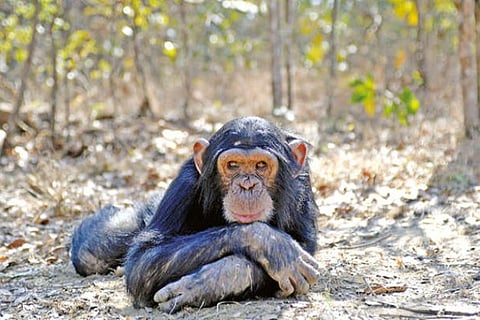

Chennai
Pretty soon, they were trying it, too: first her son, then her two closest female friends, then a male friend, out to eight of the 10 chimps in the group, all of them struggling, in front of Julia the Influencer — and hidden video cameras — to get the grass-in-the-ear routine just right. “It was quite funny to see,” said Edwin van Leeuwen of the University of Antwerp, who studies animal culture. “They tried again and again without success. They shivered through their whole bodies.”
Dr. van Leeuwen tried it himself and understood why. “It’s not a pleasant feeling, poking a piece of grass far enough into the ear to stay there,” he said. But once the chimpanzees had mastered the technique, they repeated it often, proudly, almost ritualistically, fiddling with the inserted blades to make sure others were suitably impressed.
Julia died more than two years ago, yet her grassy-ear routine — a tradition that arose spontaneously, spread through social networks and skirts uncomfortably close to a human meme or fad — lives on among her followers in the sanctuary. The behavior is just one of many surprising examples of animal culture that researchers have lately divulged, as a vivid summary makes clear in a recent issue of Science. Culture was once considered the patented property of human beings: We have the art, science, music and online shopping; animals have the instinct, imprinting and hard-wired responses. But that dismissive attitude toward non-human minds turns out to be more deeply misguided with every new finding of animal wit or whimsy: Culture, as many biologists now understand it, is much bigger than we are. “If you define culture as a set of behaviours shared by a group and transmitted through the group by social learning, then you find that it’s widespread in the animal kingdom,” said Andrew Whiten, a psychologist and neuroscientist at the University of St. Andrews, in Scotland, and the author of the Science review. “You see it from primates and cetaceans, to birds and fish, and now we even find it in insects.” Culture “is another inheritance mechanism, like genes,” Hal Whitehead of Dalhousie University, who studies culture in whales, said. “It’s another way that information can flow through a population.” But culture has distinct advantages over DNA when it comes to the pace and direction of information trafficking. Whereas genetic information can only move vertically, from parent to offspring, cultural information can flow vertically and horizontally: old to young, young to old, peer to peer, no bloodlines required.
Genes lumber, but culture soars. In 1980, for example, an observant humpback whale discovered that by smacking its tail hard against the water, the tiny fish on which it preyed were prompted to ball up into tidy packages fit for comparatively easy capture and consumption. The enhanced hunting technique, called lobtail feeding, quickly spread along known lines of humpback social groups, aided, researchers suspect, by the cetacean talent for acrobatic mimicry among members of a pod. Today, more than 600 humpbacks are lobtail feeders. “This would only be the case if it was socially transmitted,” Dr. Whiten said.
Angier is a science reporter with NYT©2021
The New York Times
Visit news.dtnext.in to explore our interactive epaper!
Download the DT Next app for more exciting features!
Click here for iOS
Click here for Android